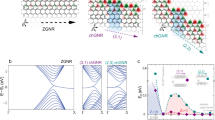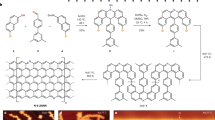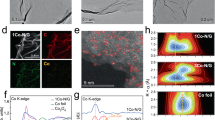Abstract
Electrical current can be completely spin polarized in a class of materials known as half-metals, as a result of the coexistence of metallic nature for electrons with one spin orientation and insulating nature for electrons with the other. Such asymmetric electronic states for the different spins have been predicted for some ferromagnetic metals—for example, the Heusler compounds1—and were first observed in a manganese perovskite2. In view of the potential for use of this property in realizing spin-based electronics, substantial efforts have been made to search for half-metallic materials3,4. However, organic materials have hardly been investigated in this context even though carbon-based nanostructures hold significant promise for future electronic devices5. Here we predict half-metallicity in nanometre-scale graphene ribbons by using first-principles calculations. We show that this phenomenon is realizable if in-plane homogeneous electric fields are applied across the zigzag-shaped edges of the graphene nanoribbons, and that their magnetic properties can be controlled by the external electric fields. The results are not only of scientific interest in the interplay between electric fields and electronic spin degree of freedom in solids6,7 but may also open a new path to explore spintronics3 at the nanometre scale, based on graphene8,9,10,11.
This is a preview of subscription content, access via your institution
Access options
Subscribe to this journal
Receive 51 print issues and online access
$199.00 per year
only $3.90 per issue
Buy this article
- Purchase on Springer Link
- Instant access to full article PDF
Prices may be subject to local taxes which are calculated during checkout




Similar content being viewed by others
References
de Groot, R. A., Mueller, F. M., van Engen, P. G. & Buschow, K. H. J. New class of materials: half-metallic ferromagnets. Phys. Rev. Lett. 50, 2024–2027 (1983)
Park, J-H. et al. Direct evidence for a half-metallic ferromagnet. Nature 392, 794–796 (1998)
Wolf, S. A. et al. Spintronics: A spin-based electronics vision for the future. Science 294, 1488–1495 (2001)
Fang, C. M., de Wijs, G. A. & de Groot, R. A. Spin-polarization in half-metals. J. Appl. Phys. 91, 8340–8344 (2002)
McEuen, P. L., Fuhrer, M. S. & Park, H. Single-walled carbon nanotube electronics. IEEE Trans. Nanotechnol. 1, 78–85 (2002)
Murakami, S., Nagaosa, N. & Zhang, S-C. Dissipationless quantum spin current at room temperature. Science 301, 1348–1351 (2003)
Sinova, J. et al. Universal intrinsic spin Hall effect. Phys. Rev. Lett. 92, 126603 (2004)
Berger, C. et al. Ultrathin epitaxial graphite: 2D electron gas properties and a route toward graphene-based nanoelectronics. J. Phys. Chem. B 108, 19912–19916 (2004)
Novoselov, K. S. et al. Two-dimensional gas of massless Dirac fermions in graphene. Nature 438, 197–200 (2005)
Zhang, Y., Tan, Y-W., Stormer, H. L. & Kim, P. Experimental observation of the quantum Hall effect and Berry’s phase in graphene. Nature 438, 201–204 (2005)
Berger, C. et al. Electronic confinement and coherence in patterned epitaxial graphene. Science 312, 1191–1196 (2006)
Fujita, M., Wakabayashi, K., Nakada, K. & Kusakabe, K. Peculiar localized state at zigzag graphite edge. J. Phys. Soc. Jpn. 65, 1920–1923 (1996)
Nakada, K., Fujita, M., Dresselhaus, G. & Dresselhaus, M. S. Edge state in graphene ribbons: nanometer size effect and edge shape dependence. Phys. Rev. B 54, 17954–17961 (1996)
Wakabayashi, K., Fujita, M., Ajiki, H. & Sigrist, M. Electronic and magnetic properties of nanographite ribbons. Phys. Rev. B 59, 8271–8282 (1999)
Miyamoto, Y., Nakada, K. & Fujita, M. First-principles study of edge states of H-terminated graphitic ribbons. Phys. Rev. B 59, 9858–9861 (1999)
Kobayashi, Y., Fukui, K-I., Enoki, T., Kusakabe, K. & Kaburagi, Y. Observation of zigzag and armchair edges of graphite using scanning tunneling microscopy and spectroscopy. Phys. Rev. B 71, 193406 (2005)
Niimi, Y. et al. Scanning tunneling microscopy and spectroscopy of the electronic local density of states of graphite surfaces near monoatomic step edges. Phys. Rev. B 73, 085421 (2006)
Okada, S. & Oshiyama, A. Magnetic ordering in hexagonally bonded sheets with first-row elements. Phys. Rev. Lett. 87, 146803 (2001)
Lee, H., Son, Y-W., Park, N., Han, S. & Yu, J. Magnetic ordering at the edges of graphitic fragments: Magnetic tail interactions between the edge-localized states. Phys. Rev. B 72, 174431 (2005)
Son, Y-W., Ihm, J., Cohen, M. L., Louie, S. G. & Choi, H. J. Electrical switching in metallic carbon nanotubes. Phys. Rev. Lett. 95, 216602 (2005)
Soler, J. M. et al. The SIESTA method for ab intio order-N materials simulation. J. Phys. Condens. Matter 14, 2745–2779 (2002)
Perdew, J. P. & Zunger, A. Self-interaction correction to density-functional approximations for many-electron systems. Phys. Rev. B 23, 5048–5079 (1981)
Lieb, E. H. Two theorems on the Hubbard model. Phys. Rev. Lett. 62, 1201–1204 (1989)
Mermin, N. D. & Wagner, H. Absence of ferromagnetism or antiferromagnetism in one- or two-dimensional isotropic Heisenberg models. Phys. Rev. Lett. 17, 1133–1136 (1966)
Gambardella, P. et al. Ferromagnetism in one-dimensional monatomic metal chains. Nature 416, 301–304 (2002)
Dorantes-Dávila, J. & Pastor, G. M. Magnetic anisotropy of one-dimensional nanostructures of transition metals. Phys. Rev. Lett. 81, 208–211 (1998)
Vindigni, A., Rettori, A., Pini, M. G., Carbone, C. & Gambardella, P. Finite-sized Heisenberg chains and magnetism of one-dimensional metal systems. Appl. Phys. A 82, 385–394 (2006)
Delin, A., Tossati, E. & Weht, R. Magnetism in atomic-size palladium contacts and nanowires. Phys. Rev. Lett. 92, 057201 (2004)
Yao, Y., Ye, F., Qi, X-L., Zhang, S-C. & Fang, Z. Spin-orbit gap of graphene. Preprint at <http://arxiv.org/abs/cond-mat/0606350> (2006)
Min, H. et al. Intrinsic and Rashba spin-orbit interactions in graphene sheets. Preprint at <http://arxiv.org/abs/cond-mat/0606504> (2006)
Acknowledgements
We thank J. Neaton, F. Giustino, I. Souza, C. H. Park and H. J. Choi for discussions. This research was supported by the National Science Foundation (NSF) and by the Director, Office of Science, Office of Basic Energy Science, Division of Material Sciences and Engineering, US Department of Energy (DOE). Computational resources have been provided by the NSF at the National Partnership for Advanced Computational Infrastructure and by the DOE at the National Energy Research Scientific Computing Center.
Author information
Authors and Affiliations
Corresponding author
Ethics declarations
Competing interests
Reprints and permissions information is available at www.nature.com/reprints. The authors declare no competing financial interests.
Supplementary information
Supplementary Figure 1
Robustness half-metallicity in defective graphene nanoribbons. (PDF 155 kb)
Rights and permissions
About this article
Cite this article
Son, YW., Cohen, M. & Louie, S. Half-metallic graphene nanoribbons. Nature 444, 347–349 (2006). https://doi.org/10.1038/nature05180
Received:
Accepted:
Issue Date:
DOI: https://doi.org/10.1038/nature05180
This article is cited by
-
Impurity atoms effects on electronic properties and Seebeck coefficient of armchair graphene like nanoribbon
Applied Physics A (2024)
-
Theoretical Insights into Band Gap Tuning Through Cu Doping and Ga Vacancy in GaSe Monolayer: A First-Principles Perspective
Journal of Electronic Materials (2024)
-
Effect of Line Defects on the Band Structures, Local Density of States, and the Landau Levels for Armchair Graphene Nanoribbons in the Quantum Hall Effect Regime
Journal of Electronic Materials (2024)
-
Linear indium atom chains at graphene edges
npj 2D Materials and Applications (2023)
-
A metal-free photoactive nitrogen-doped carbon nanosolenoid with broad absorption in visible region for efficient photocatalysis
Nature Communications (2023)
Comments
By submitting a comment you agree to abide by our Terms and Community Guidelines. If you find something abusive or that does not comply with our terms or guidelines please flag it as inappropriate.



